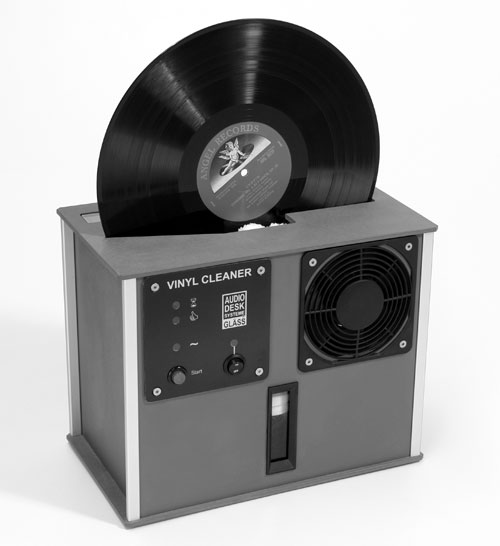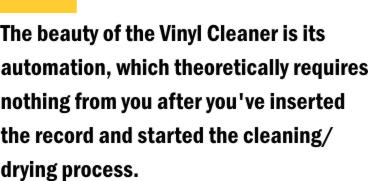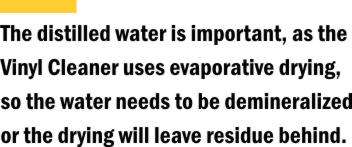Audio
Desk Systeme • Vinyl Cleaner
". . .the best machine I've used for cleaning records, both in terms of speed and effectiveness."
After getting the boxes home and pawing through them, I was ecstatic. There were dozens and dozens of Blue Note, Prestige, Verve and Riverside titles. Most, but not all, were reissues -- great music, even if they weren't wildly valuable. All were in terrific shape -- VG+ or better. There were also some blues titles that I didn't notice in my haste to get the boxes out of the auction house's dingy storeroom. Of the 600 or so LPs, I would keep about 350 of them. The rest were duplicates or titles that just didn't interest me, especially after increasing my record collection by 30 percent with this one purchase. But once the delight wore off, reality set in. How was I going to clean all of these records? I had both Loricraft and VPI machines, but at the dozen or so records I could effectively clean in three hours (I'm diligent and use more than a single fluid), it would take me years to get through them all, not to mention the records that were already in my "to be cleaned" pile. But good fortune smiled on me a second time. I talked with Robert Stein at Ultra Systems about the Audio Desk Systeme Vinyl Cleaner, for which Ultra Systems is the US distributor. Thinking that it might help lighten my cleaning load -- and three cleaning machines being better than two -- I asked about reviewing it, describing my dilemma as an opportunity for an especially thorough evaluation. Robert is an exceedingly agreeable fellow, and within a week Matt, my UPS guy (also an exceedingly agreeable fellow), was delivering the Vinyl Cleaner. Little did I know how monumental its arrival would be. hile VPI, Loricraft and Audio Desk Systeme all make record-cleaning machines, their products couldn't be much more different. With the VPI and Loricraft machines, you do most or all of the actual cleaning. The machines' primary function is removal of the cleaning fluid from the record surface, a job that both do very well indeed. Both use suction, though they apply it differently, the VPI with a wand that can remove all fluid within a few revolutions of the record, the Loricraft with an apparatus that tracks the record like a tonearm, a bit of cotton thread acting as a cushion between it and the record surface. The Vinyl Cleaner, on the other hand, lives up to its utilitarian name completely. It does clean your records -- by multiple methods. It vaguely resembles the Ronco Record Vac sold in the 1970s -- that is, you insert the record through a slot in the top and it rotates while remaining vertical. There the comparison abruptly ends, as the Vinyl Cleaner is so much more sophisticated -- and effective -- than the shoddily made Record Vac. Within the Vinyl Cleaner is a tank that holds four and a half liters of water-and-detergent mixture, a motor that spins the record, the Vinyl Cleaner's matched quad of microfiber cleaning barrels, a pump for filling the upper reservoir with the liquid in the holding tank, an ultrasonic generator, a filtration system, a pair of drying fans, and a pair of wiper blades. All of this works together to scrub dirty records clean and dry them, both sides at once, the entire process being automated. After you insert a record in the top, you choose the number of cleaning cycles by pushing the start button a corresponding number of times (one to five are available). Your choice will depend on how dirty the record is. The Vinyl Cleaner's pump fills the upper reservoir and its motor begins to spin the record. The cleaning barrels begin their work once the reservoir has finished filling. At the same time, the ultrasonic element bombards the record with very tiny bubbles; they are hard to see with the naked eye, but you can pick them out when you shine a strong flashlight into the Vinyl Cleaner. The fluid looks cloudy because of all the bubbles. After a few minutes, the cleaning ends and the drying begins. The reservoir empties and the fans force air onto the record surface while the wiper blades skim fluid off -- both sides at once. After roughly six minutes of cleaning and drying, the record spinning at various speeds, the process ends, the Vinyl Cleaner indicating this with a series of three tones. You remove the clean record, insert another dirty one, and begin again.
y take on record cleaning is that it's essential to serious analog playback. I would rather spend less money on my turntable, cartridge and phono stage than skimp on record cleaning. Furthermore, experience has proven to me that a good cleaning machine is more effective than the budget-priced Spin Clean system, which in turn is more effective than purely manual cleaning, even with state-of-the-art fluids like those from Mobile Fidelity and Audio Intelligent Vinyl Solutions. What you get for the extra cost of a cleaning machine is just what you expect: quieter records. Others have attributed specific sonic improvements -- an increase in image focus or greater midrange palpability, for instance -- to cleaning with a certain fluid or machine. Not only have I never observed this from a well-cleaned record, it makes no sense to me. If cleaning a record one way versus another changes its sound, some residue must be left behind with one of the methods, no? A cleaner record will definitely sound quieter, and that's all we should reasonably expect. However, record cleaning represents a balancing act between time and effectiveness. You can spend an afternoon cleaning one record -- applying different fluids and letting them really soak in -- and the record will most assuredly be very clean, but it will then take you a decade to finish a small pile. So you need to find a regimen that both works well and allows you to clean records quickly, or relatively speaking. Thrift stores and garage sales are a constant source of new and often dirty vinyl, not to mention the odd windfall of hundreds of records from an auction house. The Vinyl Cleaner maximizes both time and effectiveness; it cleans records at least as well as any other process I've tried -- and it may even do the job better. I say this with absolute certainty -- I've cleaned more than 800 records with the Vinyl Cleaner so far. While I haven't examined the grooves with a microscope, my ears tell me that each has been as free of noise from dust and dirt as possible, and when it comes to fingerprints, one outward sign that a record is not completely clean, the scrubbing action of the Vinyl Cleaner's microfiber barrels is more effective than any combination of fluids and brushes used with either the Loricraft or VPI machines. In fact, recleaning LPs with the Vinyl Cleaner often removed fingerprints completely. The issue of time isn't even debatable. While I can certainly clean a record with the Loricraft or VPI in the six minutes the Vinyl Cleaner takes (using a single fluid and cutting some corners), I can't go about doing other things while I'm at it. With the Vinyl Cleaner, I often walked away once the record began spinning and came back once the beeping let me know cleaning was finished. However, given the vagaries of vinyl records -- different thicknesses and warping especially -- no machine, especially one as automated at the Vinyl Cleaner, does the job perfectly each and every time. For instance, if the record isn't inserted properly (a trick that's easy to master), it won't engage with the hubs that spin it, so you'll need to give it a nudge. Also, over time I did find that drying became more iffy. I speculated that the wiper blades were wearing with each use, making drying less predictably complete. I mentioned this to Robert Stein, and he suggested that I send the review machine back for replacement of its top panel with what he called the "precision top." Outwardly this looks the same, but the mechanism for holding the wiper blades is different, pushing them toward the record surface instead of merely holding them in place. This solved the problem. If you have a Vinyl Cleaner with the original top, contact Ultra Systems for details on getting a no-cost replacement. However, even with the new top, certain very thin or noticeably warped records may not dry completely. In this case, I use a microfiber cloth to remove any droplets of fluid while the drying cycling is happening. One feature I'd love to see added is a dry-only cycle, just for these infrequent instances. The microfiber cleaning barrels will darken with use and begin to look somewhat matted, and the fluid filter, which resembles a dense sponge, will also look dingy over time. Both are specified for 500 cleanings, so you eventually need to replace them -- well, maybe. Both are sold separately: $99.95 for a set of four barrels, which are good for several hundred cleanings (perhaps even into the thousands -- see below) and $19.95 for the filter, which can easily be cleaned and is unlikely to wear out. However, when the microfiber barrels began to look ragged, I found that washing them with a load of white clothes and then letting them air dry restored them to near-new visual condition. And rinsing the filter thoroughly in distilled water removed all of the trapped gunk. I did this with each fluid change, whether the filter appeared to need it or not.
Here's a worthwhile tip regarding fluid change: keep a tally of the records you clean, so you know when you've reached the point when you need to change the fluid. Audio Desk Systeme specifies that the distilled-water-fluid mixture is suitable for cleaning 200 clean records (removal of light dust) or 100 dirty ones, and I record the number of each with pen and paper. No matter how dirty the records, the spent fluid was always as clear as water when I changed it, a testament to effectiveness of the Vinyl Cleaner's filter. On the tally I also indicate how much extra fluid I need to add as the Vinyl Cleaner is used, a quart to clean about 150 records being average. Be sure to fill the Vinyl Cleaner with the full four and a half liters of distilled water when you change fluid -- that's 152 ounces, or a gallon and three cups. This ensures that you'll have to add as little extra fluid as possible. If you add up the cost of consumables, including all of the replaceable parts and the fluid, the Vinyl Cleaner may seem expensive to operate. However, that's not really the case. The physical parts of the machine -- the wipers, cleaning barrels and fluid filter -- that you may have to purchase at some point last for hundreds and hundreds of cleaning cycles, and the cleaning fluid is mostly distilled water, which costs less than a dollar per gallon, and it's effective for up to 200 records if you're not habitually cleaning really filthy ones. All of this brings the price down to tens of cents per record -- about what you may pay for some used vinyl, but competitive with other methods and machines. t this point, you are probably thinking that the Vinyl Cleaner is a sure thing for every analog diehard and better than its competition -- the VPI Typhoon ($2300) and Loricraft PRC4 Deluxe ($3650), in my case. That's generally true, I think, but not universally so. There are a few things to consider. First, you can't clean 10" LPs with the Vinyl Cleaner, although Robert Stein has speculated that a plastic ring that clamps around the edge, making the whole thing 12" in diameter, would work. Given the slight variation that's inherent from record to record, I have my doubts about this, and it doesn't currently exist anyway. So if you have a large collection of 10" records, you won't be able to clean them with the Vinyl Cleaner. The same is true of 7" 45s. There is also the fact that with the VPI and Loricraft machines you can use multiple fluids to address the many different kinds of stains found on records. For instance, you can combine an alcohol-based cleaner, then an enzyme cleaner, followed by a water rinse, whereas with the Vinyl Cleaner you're limited to its stock mixture (you void its warranty if you use anything else). I don't find this to be bothersome, given the results I've achieved with the Vinyl Cleaner, but I concede that others may feel differently. More potentially troubling are some reported reliability issues with the Vinyl Cleaner. If you do a Google or Yahoo! search, you will find isolated reports of the Vinyl Cleaner not working as billed or breaking down completely. Most of these (as revealed by my own searches) occurred years ago, when presumably there were still bugs to be worked out. These all seem to be in the past, as reports of Vinyl Cleaners breaking down are now few and far between. Still, the makers of the various Loricraft and VPI machines have decades of near-faultless use to cite, along with larger user bases as well. Anecdotal information on reliability is on their side, although it is certainly closer to even now. The Vinyl Cleaner is not a simple device. It has motors and pumps and fans and a microprocessor to integrate them all, all of which can break down. I will say, however, that other than the aforementioned drying issues that were easily solved with a new top or a bit of intervention, the Vinyl Cleaner has worked flawlessly for me. A survey of one user is hardly definitive, but I'm sure there are others who have had the same completely positive experience. Finally, if you are worried about the labels of your records, the Vinyl Cleaner can sometimes leave droplets of fluid on them, where air from the fans can't remove them, whereas the other machines allow you to control the entire process and be more careful around the label. This is the nittiest nit to pick, however. ven with caveats great and small in mind, I can confidently say that the Audio Desk Systeme Vinyl Cleaner is the best machine I've used for cleaning records, both in terms of speed and effectiveness. Without it, most of my jazz haul would still be dirty, along with countless other records. It also does something that no turntable, cartridge or phono stage, no matter how expensive, can accomplish: reduce surface noise, often considerably compared to records cleaned by hand and even with other machines. After using the Vinyl Cleaner for many months, I refuse
to be without it, while my other cleaning machines have sat unused. I will pull them out
soon to reacquaint myself with them, although I don't foresee this being a wistful
reunion. Better is better, and the Audio Desk Systeme Vinyl Cleaner is that and more.
|
|||||||||||||




 The beauty of
the Vinyl Cleaner is its automation, which theoretically requires nothing from you after
you've inserted the record and started the cleaning/drying process. This is no small
point. Cleaning records with any other machine can be a multi-step operation, but even
when you just want to give an LP a quick once-over right before playing, you still must do
the work. The Vinyl Cleaner requires far less human involvement than either the VPI or
Loricraft machines, and it cleans records faster as well, giving you more vinyl to play
and more time to play it.
The beauty of
the Vinyl Cleaner is its automation, which theoretically requires nothing from you after
you've inserted the record and started the cleaning/drying process. This is no small
point. Cleaning records with any other machine can be a multi-step operation, but even
when you just want to give an LP a quick once-over right before playing, you still must do
the work. The Vinyl Cleaner requires far less human involvement than either the VPI or
Loricraft machines, and it cleans records faster as well, giving you more vinyl to play
and more time to play it. The Vinyl Cleaner's fluid consists of four and a half liters of distilled water
and one bottle of the special Audio Desk Systeme cleaner. The distilled water is
important, as the Vinyl Cleaner uses evaporative drying, so the water needs to be
demineralized or the drying will leave residue behind. Even ultra-pure lab-grade water
will leave residue unless it's also distilled. As the Vinyl Cleaner is used, its fluid
evaporates through use -- and simply because that's what fluid does. So while you will
begin with a little more than four and a half liters of cleaning mixture, eventually you
will have to add more. The Vinyl Cleaner will indicate when it's low and prevent further
use until fluid is added. Keep a gallon of water-fluid mixture handy for topping off.
The Vinyl Cleaner's fluid consists of four and a half liters of distilled water
and one bottle of the special Audio Desk Systeme cleaner. The distilled water is
important, as the Vinyl Cleaner uses evaporative drying, so the water needs to be
demineralized or the drying will leave residue behind. Even ultra-pure lab-grade water
will leave residue unless it's also distilled. As the Vinyl Cleaner is used, its fluid
evaporates through use -- and simply because that's what fluid does. So while you will
begin with a little more than four and a half liters of cleaning mixture, eventually you
will have to add more. The Vinyl Cleaner will indicate when it's low and prevent further
use until fluid is added. Keep a gallon of water-fluid mixture handy for topping off.